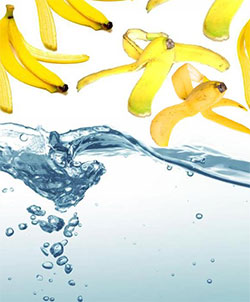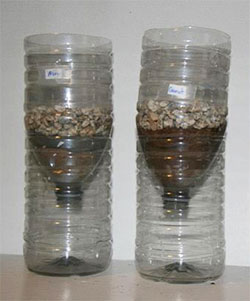Filter and purify water with fruit
 There is a cheap and easy way for any community in the developed (or underdeveloped) world to purify their water. The peels of some of the most widely consumed fruits in the world are remarkably efficient at absorbing a wide variety of harmful pollutants, including heavy metals, and they can be transformed into effective water filters with only minor preparation.
There is a cheap and easy way for any community in the developed (or underdeveloped) world to purify their water. The peels of some of the most widely consumed fruits in the world are remarkably efficient at absorbing a wide variety of harmful pollutants, including heavy metals, and they can be transformed into effective water filters with only minor preparation.
Banana Peels
Minced banana peels could be used repeatedly to purify water contaminated by industrial plants and farms – up to 11 times – and still be effective. In a study paper titled Banana Peel Applied to the Solid Phase Extraction of Copper and Lead from River Water: Preconcentration of Metal Ions with a Fruit Waste researchers noted the very low cost of banana peels and the fact there is no need to prepare them chemically for the water purification procedure.
Author Gustavo Castro and colleagues note that mining processes, runoff from farms, and industrial wastes can all put heavy metals, such as lead and copper, into waterways. Heavy metals can have adverse health and environmental effects. Current methods of removing heavy metals from water are expensive, and some substances used in the process are toxic themselves.
Compounds in banana peels contain atoms of nitrogen, sulfur and organic compounds such as carboxylic acids. These acids are charged such that their negatively charged electron pairs are exposed, meaning they can bind with metals in the water that usually have a positive charge, Castro explained.
Apple & Tomato Peels
Researcher Ramakrishna Mallampati originally thought up the method as an easy, cheap way for rural communities in the developing world to purify their water. He found that apple and tomato peels – two of the most widely consumed fruits in the world – were remarkably efficient at absorbing a wide variety of harmful pollutants, and that they could be transformed into effective water filters with only minor preparation.
To make use of Mallampati’s technique yourself, begin by peeling your apples and tomatoes and placing them in a rubbing alcohol solution and letting them soak. Next, remove the peels and let them dry out. Once they’re thoroughly desiccated, simply place the peels in a container of water and wait. After a few hours, remove the peels from the water and it’s ready to drink.
Mallampati found that the apple and tomato peels together were reliable absorbents of toxic heavy metal ions, dissolved organic and inorganic chemicals, various nanoparticles, dyes and pesticides.
Coconut Fiber & Rice Husks
 In 1972, the researchers worked on the development of a new filter approach in Thailand which on a laboratory scale appeared to have wide applicability for both water purification and wastewater treatment in Southeast Asia. This appropriate technology type filter consists of two stages. The first is made up of the fibers from shredded coconut husks to filter out the bulk of suspended solids from the water; the second is a bed of burnt rice husks to “polish” the water removing residual turbidity and other contaminants. The filter thus utilizes local materials that are both widely available and inexpensive enough to discard after use, thus eliminating backwashing. The media are used in series so that filtration alone can do the job in most cases without use of chemicals. In addition, with burnt rice husks as a filtering medium, the process includes significant absorption capability for taste, odor, and color removal.
In 1972, the researchers worked on the development of a new filter approach in Thailand which on a laboratory scale appeared to have wide applicability for both water purification and wastewater treatment in Southeast Asia. This appropriate technology type filter consists of two stages. The first is made up of the fibers from shredded coconut husks to filter out the bulk of suspended solids from the water; the second is a bed of burnt rice husks to “polish” the water removing residual turbidity and other contaminants. The filter thus utilizes local materials that are both widely available and inexpensive enough to discard after use, thus eliminating backwashing. The media are used in series so that filtration alone can do the job in most cases without use of chemicals. In addition, with burnt rice husks as a filtering medium, the process includes significant absorption capability for taste, odor, and color removal.
Solar Disinfection with Lime
A natural, cheap and effective water purifier for the world.
Solar disinfection of water combined with almost any type of citrus is very effective at reducing dangerous E. coli levels, however limes seem to work best. A recent study published by the Johns Hopkins University School of Medicine found that adding limes to water that is being disinfected by the sun speeds up the disinfection process.
The preliminary results of this study show solar disinfection of water combined with citrus could be effective at greatly reducing E. coli levels in just 30 minutes, a treatment time on par with boiling and other household water treatment methods. In addition, the 30 milliliters of juice per 2 liters of water amounts to about one-half Persian lime per bottle, a quantity that will likely not be prohibitively expensive or create an unpleasant flavor.
Please note that these methods do not remove all pathogens from the water, just a wide variety of pollutants, so you shouldn’t use them as an all-encompassing water purifiers.
yogaesoteric
August 4, 2017
